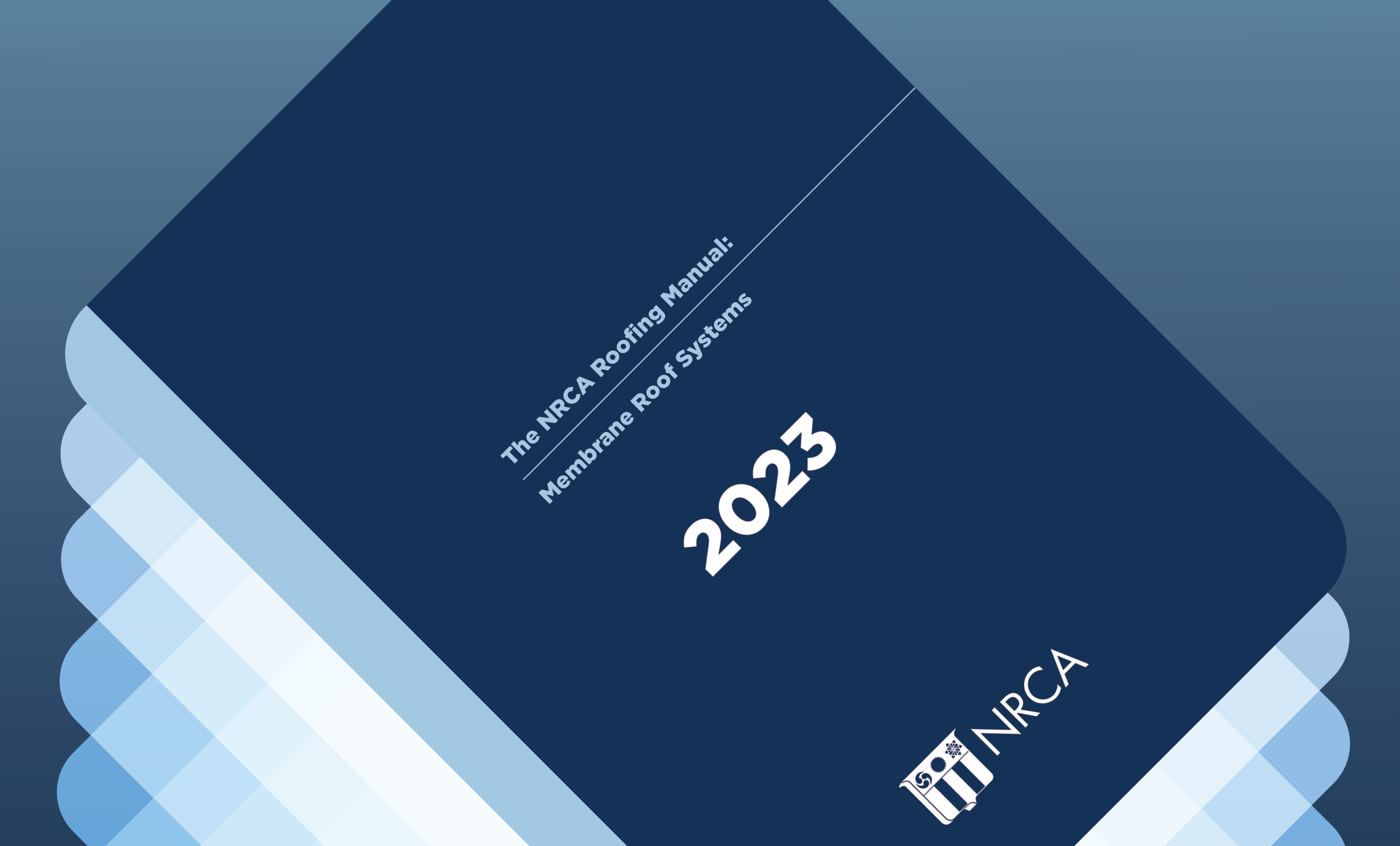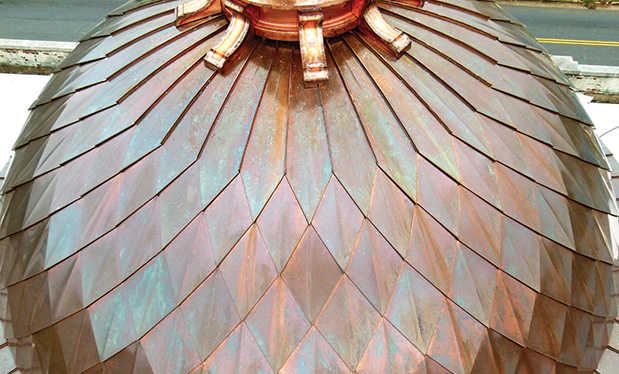The use of spray polyurethane foam roofing is increasing because of a combination of factors, including overall product performance, weather resiliency, climate change concerns and, more recently, economic conditions that are driving up demand for cost-effective roof system retrofit options, such as SPF.
SPF at a glance
SPF commonly is applied in low-slope roofing applications. With a 2.5- to 3.5-pound density per cubic foot, SPF is among the most dense and rigid of SPF building product options (open- and closed-cell SPF insulation are two other less dense solutions for building envelopes), offering a compressive strength of 40 to 60 pounds per inch. When used on roofs, the material forms a monolithic layer that protects the structure underneath and acts as a continuous thermal insulation layer, water and air barrier, as well as vapor retarder.
An elastomeric roof coating is applied on top of the foam to further enhance energy efficiency and prevent degradation and damage caused by ultraviolet radiation, common weather variables and maintenance-related foot traffic. Butyl rubber, polyurethane and polyurea are suitable roof coatings for application atop SPF though silicone and acrylic are more commonly used.
SPF is ideal for use in the following roofing conditions and situations:
- Roof decks of unusual shape
- Local climates prone to inclement weather, storms, wind and/or hail (coastal and hurricane prone regions are two examples)
- When sloped roof application is mandated for drainage purposes
- When the substrate includes multiple penetrations (such as with solar panel supports) or equipment is mounted to the roof and requires flashing
- Structures unable to withstand additional weight
- When expenses associated with removal of an existing roof are too great (SPF may be applied over an existing roof as a cost-effective retrofit application.)
With proper maintenance, care and periodic recoating every 10 to 20 years, SPF can be a durable roofing option with a lifespan of 50 or more years.
SPF and the climate
The Intergovernmental Panel on Climate Change has noted gases from human activities, a primary cause of climate change, are found to be responsible for 1.1 degrees Celsius of the Earth’s warming since 1850-1900 and, during the next 20 years, the global temperature is expected to reach or exceed 1.5 degrees Celsius of warming.
Climate warming has brought about numerous pronounced, visible weather changes, including an increase in hurricanes, longer droughts and intense storms.
After Hurricane Katrina, the National Institute of Standards and Technology reviewed roof systems and discovered buildings roofed with SPF performed well without blow-off of the SPF or damage to flashings. NIST’s 2006 Performance of Physical Structures in Hurricane Katrina and Hurricane Rita: A Reconnaissance Report found only one of the examined SPF roofs incurred notable damage and concluded SPF kept the roofs intact, prevented moisture from entering the buildings, and protected the structures from hail and debris.
In addition, SPF can act as an insulator and air barrier, sealing a roof and reducing heating and cooling energy demands. In reducing energy use, the material also can reduce greenhouse gases generated from fossil fuel combustion, which can help reduce global warming effects.
SPF and PV
Global warming, combined with the growing cost of fossil fuels, is further intensifying the necessity of decarbonizing, or reducing the carbon output of, buildings and homes. In the 2018 Decarbonizing U.S. Buildings report published by the Center for Climate and Energy Solutions, it was found fossil fuel combustion attributed to residential and commercial buildings accounted for roughly 29% of total U.S. greenhouse gas emissions.
But to fully decarbonize buildings and homes, we must also make sure they generate renewable energy. Although SPF is incapable of fulfilling the energy-generation component of a successful decarbonization strategy, it can reduce energy consumption and pairs nicely with photovoltaic technology, which is capable of renewable energy generation.
In fact, the two systems are increasingly used together to help eliminate a structure’s dependence on fossil fuel-consuming energy sources. Detailed guidance on the design and installation considerations for pairing the two systems can be found in the Spray Polyurethane Foam Alliance’s SPFA-150 Photo-Voltaic Systems and SPF Roof Systems technical document available at sprayfoam.org/SPFA_techdocs.
Blowing agents
The SPF industry is undergoing a meaningful shift in its materials technology. The change pertains directly to blowing agent technology; the industry has begun to adopt and use hydrofluoroolefin-based blowing agents in spray foam. This move toward HFO blowing agents is a gradual shift away from hydrofluorocarbons. HFO blowing agents are composed of unsaturated organic compounds of hydrogen, fluorine and carbon and offer zero ozone depletion potential and move the global warming potential of spray foams from a factor greater than 794 to, in some cases, just 1, according to the Environmental Protection Agency. These metrics showcase how instrumental the newer blowing agent technology is in dramatically reducing the industry’s contributions toward climate change.
U.S. federal government initiatives and support of the phasedown of ozone-depleting chemicals, as well as those producing greenhouse gases, has varied by administration. Currently, manufacturers, contractors and regulations are what are primarily driving the shift toward HFO-based blowing agents.
The states phasing out the use of HFCs are using EPA’s SNAP program rules 20 and 21, which push for a shift to environmentally friendly blowing agents (and which were partially vacated at the federal level) as a guide for statewide regulations. And though there are a significant number of states in the process, they are in different phases. For example, California, New York and Washington lead the pack, having established regulations that curb HFC emissions and are stricter than SNAP 20 and 21 rules. Colorado, Delaware, Maine, Maryland, Massachusetts, New Jersey, Rhode Island, Vermont and Virginia have legislations aligned with SNAP 20 and 21 prohibiting the use of certain HFCs. Connecticut, Hawaii, New Mexico, Oregon, Pennsylvania and Texas have indicated a desire to introduce legislation to reduce HFC emissions, but as of press time, no bills have been signed into law. At some point, Illinois, Louisiana, Michigan, Minnesota, Nevada, North Carolina and Wisconsin may follow suit as they are part of the U.S. Climate Alliance, a group of states that have committed to mitigating global warming.
New EPD
Since 2012, SPFA, working with Chicago-based environmental software company Sphera, has developed International Standards Organization-compliant life-cycle assessment and environmental product declarations for SPF insulation and roofing foams. Comparison of the EPDs for SPF using HFC and HFO blowing agents show a five-fold reduction in global warming when using HFO blowing agents. In 2023, SPFA will conduct a five-year update for all SPF materials per ISO requirements.
Tax incentives and rebates
Of consequence to all SPF contractors, as well as roofing contractors in general, is the Inflation Reduction Act, federal legislation signed into law in August 2022 by President Biden. The act provides billions of dollars to supplement federal energy efficiency initiatives through tax credits and deductions, as well as rebate, grant and loan programs. Many contractors are sharing the information with their customers to explain that now might be a good time to complete the energy efficiency-focused retrofits they have been considering.
Following is an overview of some of the Inflation Reduction Act’s core benefits, specifically those that may apply to the services roofing contractors provide:
- Residential Efficiency Tax Credit (25C): Initially created under the Energy Policy Act of 2005 and added to the federal tax code under Section 25C, this program has been expanded and extended under the Inflation Reduction Act’s Section 13301 and provides tax credits for installing certain energy-efficient insulation, windows, doors and roofing materials. For improvements completed in 2023, the new terms allow a 30% tax credit up to an annual maximum of $1,200, which is a significant increase from the former 10% tax credit with a $500 lifetime maximum.
- HOMES Act: The Home Owner Managing Energy Savings Act of 2019 directs the Department of Energy to establish the Home Energy Savings Retrofit Rebate Program to provide rebates rewarding homeowners for achieving home energy savings. Rebates provided are based on measured or estimated (modeled) energy savings as determined by an energy audit using DOE-approved software and are available to homeowners and aggregators for single-family and multifamily properties. The rebates may not be combined with any other federal grants or rebates with the exception of the homeowner tax credits under Section 25C. Rebate amounts are substantial but vary based on measured versus modeled energy savings. For multifamily properties to qualify, not less than 50% of the dwelling units must be occupied by low- or moderate-income households.
- DOE Electrification Rebate Program: Section 50122 of the legislation provides $4.5 billion to DOE to support state-level rebate programs for home electrification upgrades that include provisions for air sealing and insulation. The program’s objective is to reduce the number of homes and buildings heated by direct combustion of fossil fuels (oil, natural gas, propane, coal and wood). The government is incentivizing a transition to all-electric heating ultimately powered by wind and solar. During this transition process, downsizing these new electric heating systems is essential. There are opportunities, albeit smaller, for insulation and air sealing from SPF roof systems as part of this program. The maximum rebate for air sealing, insulation and ventilation is $1,600, subject to household income requirements. The electrification rebate is available for single-family and multifamily properties and may not be combined with other federal grants or rebates with the exception of homeowner tax credits under 25C.
- New and existing commercial buildings incentives: With the goal of decreasing energy consumption in buildings across the U.S., tax deductions may be claimed by owners of commercial and large multi-family buildings who install qualifying energy efficiency measures, including building envelope improvements. Enhancements to energy efficiency needed to qualify for the deduction must be demonstrated by energy simulation (modeling) by an independent third party or actual energy use. In either case, an SPF roof system can play an important role in increased building efficiency. Savings requirements vary based on the path chosen, and tax deductions per square foot vary based on taxable year.
Opportunities
The SPF sector is undergoing significant change amidst product chemistry enhancements, an increased emphasis on the material’s ability to perform in the face of extreme weather and storms, wider adoption of SPF roofing combined with photovoltaics, and major tax incentives; however, much of that change represents meaningful business opportunities for roofing contractors who can capitalize on them.
RICK DUNCAN, Ph.D., P.E., is executive director of the Spray Polyurethane Foam Alliance.



